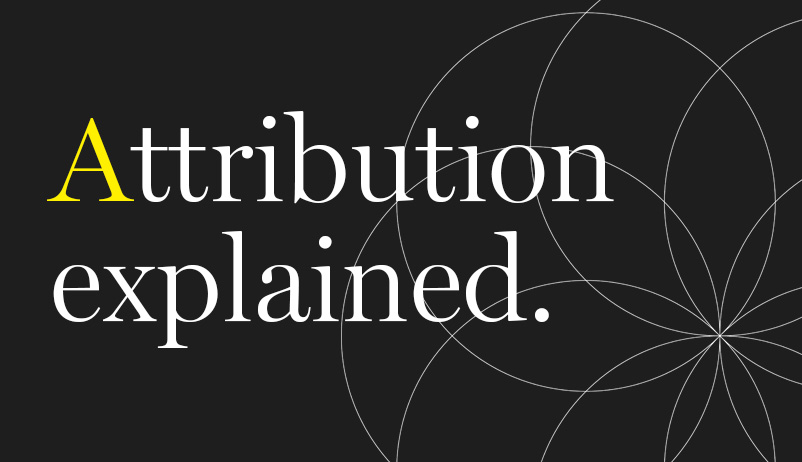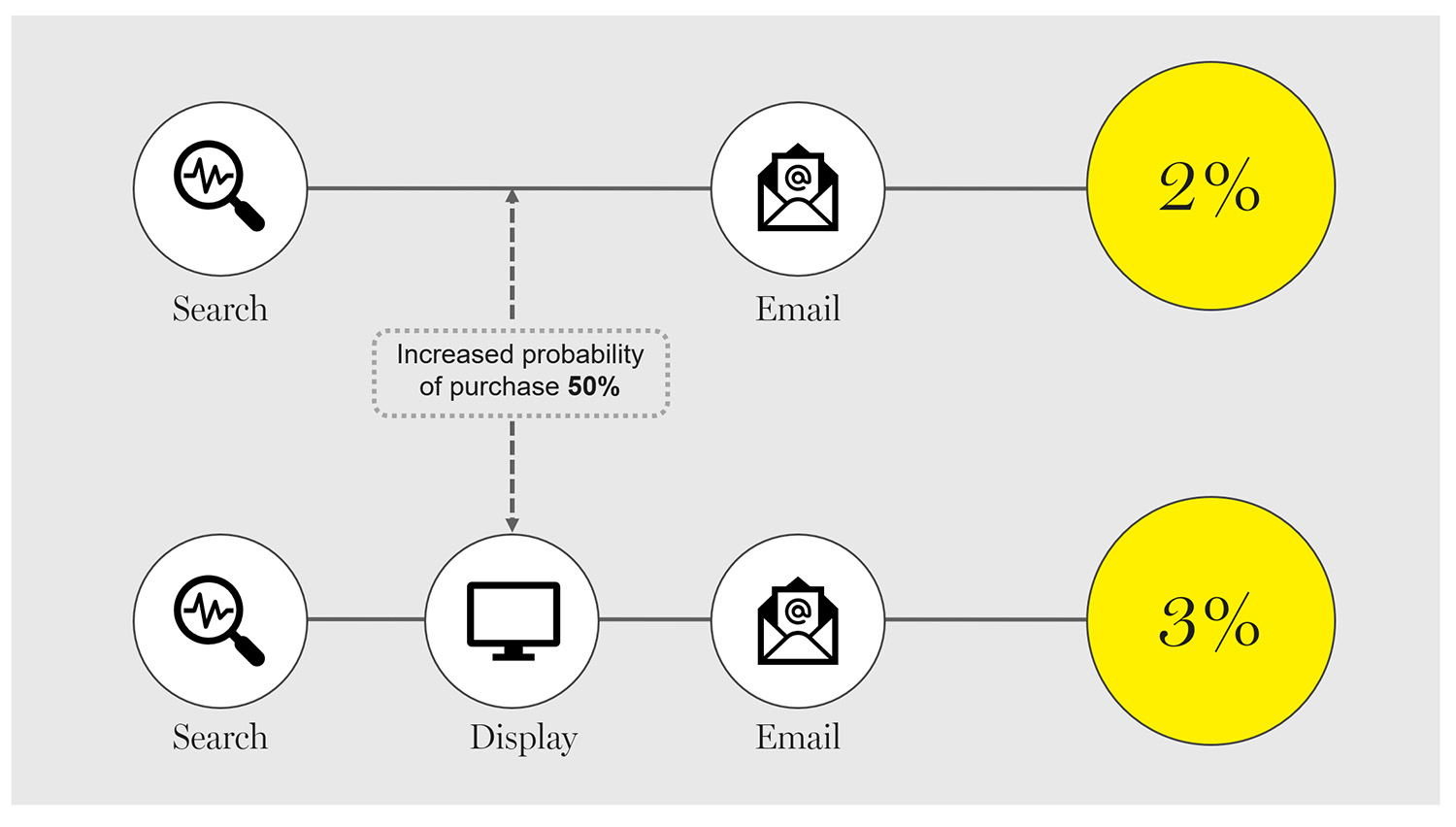

Attribution
Attribution
What Is Attribution?
Lorem ipsum dolor sit amet, consectetur adipiscing elit. Suspendisse varius enim in eros elementum tristique. Duis cursus, mi quis viverra ornare, eros dolor interdum nulla, ut commodo diam libero vitae erat. Aenean faucibus nibh et justo cursus id rutrum lorem imperdiet. Nunc ut sem vitae risus tristique posuere.
What Does Attribution Mean in Marketing?
In marketing, attribution is a buzzword that you may have heard of. It refers to the process of identifying which marketing channels or touchpoints are responsible for driving conversions or sales. In other words, it's a way of giving credit where credit is due.
Attribution is important because it helps marketers to better understand the customer journey and make more informed decisions about where to invest their marketing budgets. By knowing which touchpoints are most effective, marketers can optimise their campaigns and improve their return on investment (ROI).

"Attribution helps marketers understand the customer journey and make informed decisions about budget allocation and campaign optimisation. Tools and technologies are available to aid in attribution, but it can be complex due to the various influencing touchpoints. Despite its challenges, attribution is crucial for optimising marketing efforts and improving ROI."
Paul Mills
Founder, VCMO
Types of Attribution Models.
There are different types of attribution models that marketers can use, with each giving credit to different touchpoints along the customer journey. Here's a summary of three principal models:
1. First-Touch Attribution Model
First-touch attribution is a marketing attribution model that assigns credit for a conversion or sale to the first touchpoint or marketing channel that a customer interacts with in their customer journey. It is a single-touch attribution model that attributes the entire value of a conversion to the initial marketing touchpoint, ignoring the contributions of other marketing channels or touchpoints that may have influenced the customer along the way. Here is how it is used in marketing:
- Identifying Top-of-funnel Channels: First-touch attribution helps marketers identify the marketing channels that are driving initial awareness and interest among the target audience. By attributing conversions to the first touchpoint, marketers can identify which channels are most effective at generating top-of-funnel leads and driving traffic to the website or other marketing assets.
- Budget Allocation: First-touch attribution can impact budget allocation decisions. If certain channels are consistently driving the initial touchpoints that result in conversions, marketers may choose to allocate more budget towards those channels to maximise the top-of-funnel impact and generate more leads or customers.
- Campaign Optimisation: First-touch attribution can help marketers optimise their marketing campaigns by identifying which campaigns or initiatives are most effective at capturing customers' attention at the beginning of their customer journey. This information can be used to fine-tune marketing strategies, creative assets, and messaging to better align with the channels that are driving initial touchpoints and conversions.
- Performance Evaluation: First-touch attribution is often used as a way to evaluate the performance of individual marketing channels or campaigns. By attributing conversions to the first touchpoint, marketers can measure the effectiveness of each channel or campaign in driving initial customer engagement and generating leads or sales.
- Customer Journey Analysis: First-touch attribution can provide insights into the early stages of the customer journey and how customers initially interact with a brand. This information can help marketers understand the customer decision-making process and identify opportunities to improve customer engagement and retention strategies.
- Benchmarking and Comparisons: First-touch attribution can be used to benchmark and compare the performance of different marketing channels or campaigns in generating initial touchpoints and conversions. Marketers can use this information to make data-driven decisions on resource allocation, campaign optimisation, and overall marketing strategy.
2. Last-Touch Attribution Model
Last-touch attribution is a marketing attribution model that assigns credit for a conversion or sale to the last touchpoint or marketing channel that a customer interacts with before completing the desired action. It is a single-touch attribution model that attributes the entire value of a conversion to the last marketing touchpoint, disregarding the contributions of other marketing channels or touchpoints that may have influenced the customer along the customer journey. Here is how it is used in marketing:
- Identifying Closing Channels: Last-touch attribution helps marketers identify the marketing channels that are most effective in driving the final conversion or sale. By attributing conversions to the last touchpoint, marketers can determine which channels are driving the last engagement that leads to a conversion and optimise their marketing and remarketing strategies accordingly.
- Budget Allocation: Last-touch attribution can impact budget allocation decisions. If certain channels are consistently driving the final touchpoints that result in conversions, marketers may choose to allocate more budget towards those channels to optimise their efforts in closing the sales funnel and generating revenue.
- Campaign Optimisation: Last-touch attribution can help marketers optimise their marketing campaigns by identifying which campaigns or initiatives are most effective at driving the last engagement and conversions. This information can be used to fine-tune marketing strategies, creative assets, and messaging to better align with the channels that are driving the final touchpoints and conversions.
- Performance Evaluation: Last-touch attribution is often used as a way to evaluate the performance of individual marketing channels or campaigns in driving the final conversions or sales. By attributing conversions to the last touchpoint, marketers can measure the effectiveness of each channel or campaign in closing the sales funnel and generating revenue.
- Customer Lifetime Value Analysis: Last-touch attribution can provide insights into the impact of marketing efforts on customer lifetime value (CLTV). By understanding which channels are driving the final touchpoints and conversions, marketers can analyse the long-term value of customers acquired through different marketing channels and optimise their strategies to focus on higher CLTV channels.
- Benchmarking and Comparisons: Last-touch attribution can be used to benchmark and compare the performance of different marketing channels or campaigns in generating final touchpoints and conversions. Marketers can use this information to make data-driven decisions on resource allocation, campaign optimisation, and overall marketing strategy.
3. Multi-Touch Attribution Model
Multi-touch attribution is a marketing attribution model that considers and assigns credit for a conversion or sale to multiple touchpoints or marketing channels that a customer interacts with along their customer journey. Unlike single-touch attribution models such as first-touch or last-touch attribution, which attribute the entire value of a conversion to a single touchpoint, multi-touch attribution acknowledges that multiple touchpoints may contribute to a conversion and assigns partial credit to each of them. Here is how it is used in marketing:
- Comprehensive View of Customer Journey: Multi-touch attribution provides marketers with a more comprehensive view of the entire customer journey, considering all the touchpoints that a customer interacts with before making a conversion or purchase. This helps marketers understand the holistic impact of various marketing channels and touchpoints in driving conversions and optimising their marketing strategies accordingly.
- Allocating Credit to Multiple Touchpoints: Multi-touch attribution assigns partial credit to multiple touchpoints along the customer journey, considering their unique contribution in influencing the customer's decision-making process. This allows marketers to better understand the role of each touchpoint in the conversion path and allocate credit proportionally, leading to more accurate measurement and optimisation of marketing efforts.
- Budget Allocation: Multi-touch attribution helps marketers make informed decisions about budget allocation across different marketing channels or touchpoints. By understanding the contribution of each touchpoint in the conversion path, marketers can allocate resources and budget more effectively, optimising their marketing mix to achieve better results and ROI.
- Campaign Optimisation: Multi-touch attribution can inform campaign optimisation strategies by identifying which campaigns or initiatives are most effective at driving conversions or influencing the customer journey. Marketers can use this information to fine-tune their campaigns for remarketing, creative assets, and messaging across different touchpoints to better align with the customer journey and optimise their marketing efforts.
- Performance Evaluation: Multi-touch attribution provides a more nuanced and accurate way to evaluate the performance of different marketing channels or campaigns. By considering the contributions of multiple touchpoints, marketers can gain insights into the effectiveness of each channel or campaign in driving conversions and make data-driven decisions on performance optimisation.
- Customer Segmentation and Personalisation: Multi-touch attribution can help marketers segment customers based on their interactions with different touchpoints, allowing for more personalised marketing strategies. By understanding which touchpoints are most influential for different customer segments, marketers can tailor their messaging, offers, and campaigns to better resonate with each segment and improve overall customer experience.
- Data-Driven Decision Making: Multi-touch attribution relies on data and analytics to accurately assign credit to different touchpoints, enabling marketers to make data-driven decisions based on evidence and insights. This helps marketers optimise their marketing strategies, allocate resources effectively, and continuously improve their marketing efforts based on real-time data and feedback.
Tools for Attribution.
There are a variety of tools and technologies available to help marketers with attribution. These can include analytics platforms, tag management systems, and attribution modelling tools. These tools can help to automate the process of collecting and analysing data from different touchpoints, making it easier to identify which channels are most effective.
Benefits & Challenges of Attribution.
By using attribution, marketers can gain a more complete understanding of the customer journey and make more informed decisions about where to invest their marketing budgets. Attribution can help to optimise campaigns, improve ROI, and increase customer acquisition and retention.
Conversely, attribution can be a complex process because there are many different touchpoints that can influence a customer's decision to make a purchase. It can be difficult to accurately attribute sales or conversions to a specific marketing channel or touchpoint. Additionally, different attribution models can produce different results, making it challenging to compare results across campaigns.
Recap of Attribution.
In conclusion, attribution is a key concept in the world of marketing. By using attribution models and tools, marketers can gain a better understanding of the effectiveness of their campaigns and make data-driven decisions to improve their results. While attribution can be challenging, it is an essential part of any successful marketing strategy.
About VCMO
VCMO is a UK-based provider of fractional marketing services, supporting B2B SMEs—ranging from funded scale-ups to mid-tier and private equity-backed businesses—through key moments of growth and transformation. Its Chartered Fractional CMOs and SOSTAC® certified planners embed strategic marketing leadership into organisations navigating product launches, new market entry, acquisitions, and leadership gaps.
Ready to take your marketing to the next level? Let us help you get there.
Subscribe to Our Newsletter
Fractional Edge is our montly newsletter sharing expert opinion on the latest trends in fractional leadership, curated marketing content from leading sources, VCMO events, and much more. Subscribing is quick — just add your name and email.










